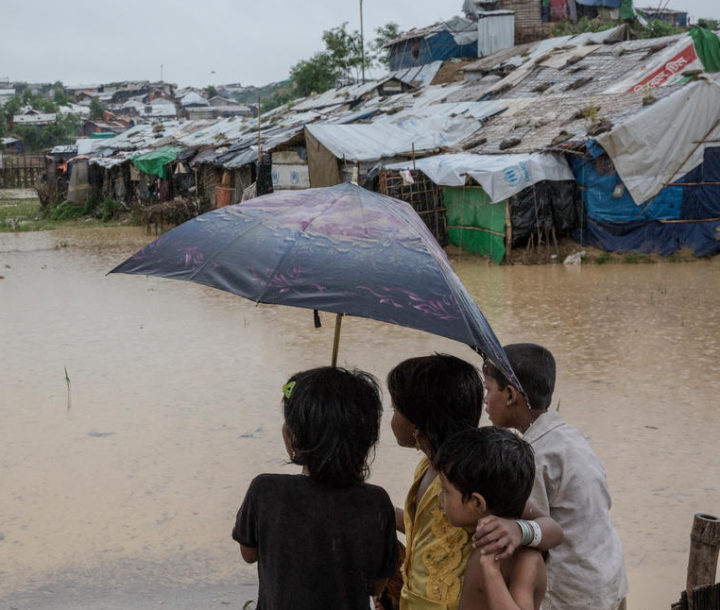Climate change is a threat multiplier, exacerbating the number and severity of health problems facing individuals and communities globally. And as health problems increase, so too will the challenges that humanitarian organisations face.
The following key learnings offer insight into the challenges, and potential solutions, facing humanitarian health actors in a climate change world. They come from our recent symposium on Climate Change and Humanitarian Health, which brought together NGOs, government, academia and the private sector delegates from agencies across the Asia-Pacific.
1. The health impacts of climate change go beyond communicable diseases
It is well established that climate change effects will be felt most keenly in low-income settings and by those who are more vulnerable such as children, the elderly and the ill. In humanitarian contexts, the effects of extreme heat, malaria, diarrhoea disease and dengue will require increased attention, especially so in urban and informal settlements. Respiratory illnesses are also set to be on the rise. As humanitarian need extends to middle- and higher-income settings, the burden of non-communicable diseases such as diabetes and cardiovascular disease is also increase due to climate effects.
Those at the front lines of climate change are observing that as the time between disasters decreases, the mental health and psychosocial effect on affected populations are becoming increasingly prevalent.
2. Humanitarians can no longer ‘get in and get out’
As a threat multiplier, climate change will worsen drivers of humanitarian crises such as food insecurity and scarcity of essential resources. Migration, as an identified climate adaptation response, is set to increase as populations move to reduce their exposure to events, or increase their opportunities for nutrition, water and access to health care.
Climate change is also contributing to the ‘typology shift’ of humanitarian crises in becoming more protracted. The long-term nature of climate change means longer-term thinking by humanitarian organisations will be required. “Getting in and getting out” will no longer a relevant way of operating.
There are however tensions in the humanitarian-development nexus that need to be navigated in moving forward with this typology and response change. The good news is that there are identifiable synergies with health programming and disaster risk reduction, development and capacity building programmes that already exist within many organisations. Recognition of these synergies will help to progress climate informed practice so as well as a threat multiplier, climate change may be a “solutions multiplier”.
3. Climate change is not just another silo
Climate change poses multiple threats to vulnerable populations and for effective action, climate change cannot be considered another ‘silo’. Humanitarian action on health and climate must be integrated across organisational programmes, particularly WASH, livelihoods and nutrition. Embedding an organisational ‘focal point’ on climate change can be a good way to manage this.
In progressing climate change action on health more broadly, working with national authorities such as National Disaster Management Agencies and Ministries of Health are critical success factors. There are also opportunities for increased inter-agency cooperation and coordination at the sector level for humanitarian and development actors.
4. There is still a data gap
The direct attribution of climate change to humanitarian crises remains challenging.
There are significant volumes of work on the attribution of quick-moving stressors such as health and vector-borne disease, but with the majority of data coming from well resourced, high-income settings context-specific gaps remain. The lack of data from humanitarian contexts is recognised as a challenge by humanitarian organisations in their planning, and similarly for researchers looking to progress knowledge in the climate and health space.
5. Planning needs to account for multiple climate futures
Humanitarian organisation need to consider two time scales when planning for climate futures: now until 2030 under a +1.5°C scenario; and 2030 – 2050 under a +2°C scenario. Looking beyond 2050, organisations need to be integrating +1-4°C scenarios into organisational strategies to build climate resilience in the long term. Engaging with the science – and the global conversation on climate – will help humanitarian organisations stay informed and up-to-date.
Humanitarian organisation are, and will continue to be, questioned on their own climate impact so need to be prepared to “have their house in order” with respect to climate, while still being prepared to advocate and programme for resilience. Internally, bottom-up advocacy can be critical to operationalising climate action, but engaged and accountable leadership is also required.
6. Humanitarians can – and must – advocate for climate action
There is a strong consensus that humanitarian organisations need to advocate for climate action. But in undertaking this, organisations need to give due consideration to humanitarian principles, carefully chose context and avoid being party political.
With the proven power of alliances in advocating for health and climate, coordination becomes particularly important. Coordinated communications means that focus messages can be aligned and mixed messaging minimised. To maximise engagement in the political sphere, humanitarian and development actors will need to be able to communicate effectively to policy makers about how programmes will improve health outcomes and promote social cohesion. In achieving long-lasting action, identification of the co-benefits of climate action for health and engaging champions outside of the organisation or the sector can be effective.
7. Programming with a ‘systems view’ is crucial
Humanitarians can respond to climate change through both adaptation and mitigation activities. Programmes that improve basic health measures, including public awareness and information campaigns, are one of the most effective measures to reduce vulnerability to climate change. Taking a ‘systems view’ of health interventions is imperative and will help to align on-ground action with broader national and international initiatives, such national adaptation planning.
Whist there is a lot to do, guiding resources are available to assist humanitarian actors. The WHO Operational Framework for Building Climate Resilient Health Systems and, for those operating in the Pacific, the Special Initiative on Climate change and health in Small Island Developing States provide good starting points.
Financing for climate and health is also becoming increasingly available. Major donors such as the Asian Development Bank, World Bank and Green Climate Fund recognise the importance of investing in health mitigation and adaptation activities and are looking to support activities in this space.
You can help build an evidence base for action
For people at the front lines, the effects of climate change on their health is not a future concept. It is happening now with those most vulnerable set to suffer the greatest health consequences.
We’re asking whether humanitarian organisations ready. You can contribute to this important ongoing research by taking a short survey online now.


